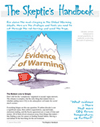|
|
Finally climate scientists are starting to ask how the models need to change in order to fit the data. Hans von Storch, Eduardo Zorita and authors in Germany pointedly acknowledge that even at the 2% confidence level the model predictions don’t match reality. The fact is, the model simulations predicted it would get warmer than it has from 1998-2012. Now some climate scientists admit that there is less than a 2% chance that the models are compatible with the 15-year warming pause, according to the assumptions in the models.
In a brief paper they go on to suggest three ways the models could be failing, but draw no conclusions. For the first time I can recall, the possibility that the data might be wrong is not even mentioned. It has been the excuse du jour for years.
Note in the chart that while the 10 year “pause” passed the basic 5% test of statistical significance, by 13 years, the pause was so long that only 2% of CMIP5 or CMIP3 models simulations could be said to agree with reality. By 16 years that will be 1% of simulations. If the pause continues for 20 years, there would be “zero” […]
This beautiful graph was posted at Roy Spencer’s and WattsUp, and no skeptic should miss it. I’m not sure if everyone appreciates just how piquant, complete and utter the failure is here. There are no excuses left. This is as good as it gets for climate modelers in 2013.
John Christy used the best and latest models, he used all the models available, he has graphed the period of the fastest warming and during the times humans have emitted the most CO2. This is also the best data we have. If ever any model was to show the smallest skill, this would be it. None do.
Scores of models, millions of data-points, more CO2 emitted than ever before, and the models crash and burn. | Graph: John Christy. Data: KMNI.
Don’t underestimate the importance of the blue-green circles and squares that mark the “observations”. These are millions of radiosondes, and two independent satellite records. They agree. There is no wiggle room, no overlap.
Any sane modeler can only ask: “But how can the climate modelers pretend their models are working?” Afterall, predicting the known past with a model is not-too-hard; the modeler tweaks the assumptions, fiddles with the fudge […]
Image by Luc Viatour www.Lucnix.be
The Moon has such a big effect — moving 70% of the matter on the Earth’s surface every day, that it seems like the bleeding obvious to suggest that just maybe, it also affects the air, the wind, and causes atmospheric tides. Yet the climate models assume the effect is zero or close to it.
Indeed, it seems so obvious, it’s a “surely they have studied this before” moment. Though, as you’ll see, the reason lunar effects may have been ignored is not just “lunar-politics” and a lack of funding, but because it’s also seriously complex. Keep your brain engaged…
Ian Wilson and Nikolay Sidorenkov have published a provocative paper, Long-Term Lunar Atmospheric Tides in the Southern Hemisphere. It’s an epic effort of 14,000 words and a gallery of graphs. As these atmospheric tides swirl around the planet they appear to be creating standing waves of abnormal air-pressure that slowly circle the planet, once every 18 years. If this is right, then it could be the key to finally understanding, and one day predicting, the mysterious Pacific ENSO pattern that so affects the global climate. Even at this early stage, brave predictions are on […]
Increasing CO2 makes life easier for plants that live in hot dry places.
Thanks to satellites we know the world has “greened up” since 1980, but we were not sure how much of that was due to the fertilizing effect of CO2. To solve that, one group suggests we need to look in warm arid environments where water is the predominant limiting factor. These are the areas which ought to show whether CO2 was really helping plants grow, because when there is more CO2 it enables plants to use water more efficiently for photosynthesis. In places where there is already a lot of water, it won’t make as much difference. So Donohue et al. did that, studying regions with a low level of rainfall. They found that the fertilization effect is real and significant and that the cover in these arid zones increased 11% from 1982 – 2010 and CO2 played a significant role.
(Thanks to pollution, trees are invading grasslands. Whatever will the Greens do to get us back to the Halycon pre-carbon days? Call Gunns?)
CO2 may be the only “pollution” that greens the deserts.
“Using gas exchange theory, we predict that the 14% increase in atmospheric CO2 […]
Thermometer circa 1790
UPDATED: Post note below, with a couple of extra caveats…
Lüdecke, Hempelmann, and Weiss found that the temperature variation can be explained with six superimposed natural cycles. With only six cycles they can closely recreate the 240 year central European thermometer record. There is little “non-cyclical” signal left, suggesting that CO2 might have a minor or insignificant effect.
The three German scientists used Fourier analysis to pick out the dominant cycles of one of the longest temperature records we have. The Central European temperature is an average of records from Prague, Vienna, Hohenpeissenberg, Kremsmünster, Paris, and Munich.
The dominant cycle appears to be about 250 years. There is also a cycle of about 60 years, corresponding to the Atlantic/Pacific decadal oscillations.
Data is of course, always the biggest problem. If we had 10,000 years of high quality global records, we could solve “the climate” within months. Instead, we have short records, and Lüdecke et al, make the most of what we have. The European records are only 240 years long, or (darn) one dominant cycle, and only one region, so to check that the results are valid over longer periods they also analyze a the 2000 […]
Hyperia | Credit Wikimedia
Despite the fuss about CO2 emissions, on a global scale no one is quite sure where a lot of it ends up. Those mystery “sinks” draw in a large proportion of CO2. Here’s a big sink that just got twice as big.
Science Daily Mar. 17, 2013 — Models of carbon dioxide in the world’s oceans need to be revised, according to new work by UC Irvine and other scientists published online Sunday in Nature Geoscience. Trillions of plankton near the surface of warm waters are far more carbon-rich than has long been thought, they found. Global marine temperature fluctuations could mean that tiny Prochlorococcus and other microbes digest double the carbon previously calculated.
The trouble started when someone made an assumption.
8.8 out of 10 based on 55 ratings […]
There are probably only ten people in Australia who haven’t heard it was the Hottest Ever, Record Summer Downunder. And they were probably born yesterday.
Summer here was so scorchingly awful it was Angry. But a funny thing happened on the orbit overhead. Check out the UAH satellite data on summers since the UAH records began. The graph below (thanks to Ken) is the temperature data from the NASA satellites, processed by UAH (University of Alabama in Huntsville). Strangely there is a disparity between what the satellites recorded and the BOM.
The satellite data shows that the summer of 2012-2013 was close to ordinary, compared with the entire satellite record going back to 1979. Not a record. Not even extreme?
According to UAH satellite measurements summer in early 2013 was not a record. Not even close.
The graph data comes thanks to John Christy, Director, Earth System Science Center, Distinguished Professor, Atmospheric Science University of Alabama in Huntsville, Alabama State Climatologist and Roy Spencer. It was graphed by Ken Stewart at KensKingdom, and inspired by Tom Quirk at Quadrant. I was very happy to connect them this weekend. The data cover “average lower troposphere temperature anomalies for land grids […]
We’ve all heard the dire prophesies: Rising seas will reshape the world’s coastlines, a one meter rise will inundate 7000 sq mi of dry land, and cost over $100 billion in the United States alone. Worse, we thought things were bad before, but now it’s even rising faster than we predicted. (“We” being the unvalidated computer simulations, and “rising”, as it turns out, being one interpretation of some highly adjusted, carefully selected data, all possibly “corrected” by one outlying tide gauge in Hong Kong).
Nils-Axel Mörner is here to point out that the raw satellite data shows barely any rise, and furthermore, the observations from places all over, like the Maldives, Suriname, Tuvalu, India, Bangladesh, Venice, and Germany show not much either. It’s close enough to zero to call it “nothing”. Oh.
But that’s only spots from The Atlantic, The Pacific and The Indian… there are other oceans. 😉
As we graphed before with Frank Lansner, most of the current “rise” is due to man-made adjustments, not man-made emissions. According to Mörner, it’s not that the sea levels are rising less than expected, it’s more like they aren’t rising much at all, and haven’t been for years . — Jo
[…]
How many images have we seen of drought-stricken cracked land, or been told this is the future? How many headlines have suggested that global warming causes droughts?
Since the end of World War II humans have produced some 85% of all their CO2 emissions, but here is a new study showing that for all those emissions, and for all that warming, droughts back then were just as bad globally as they are today.
Essentially, researchers thought that the Palmer Drought Severity Index (PDSI) was the way to measure global drought levels, and they thought that warming would increase global drought conditions. But the PDSI considers only temperature, not humidity, sunlight and wind. This paper shows that when these factors are included, worldwide drought is about the same now as it was in 1950.
Researchers are finally accounting for the fact that a warmer world usually means more evaporation (especially from the ocean) and thus more rain. It’s good to see that someone has crunched those complex numbers on a global scale. Credit to Sheffield, Wood & Roderick.
Figure 1 | Global average time series of the PDSI and area in drought. a, PDSI_Th (blue line) and PDSI_PM (red line). […]
It’s hard to measure sea levels, because land often moves up and down too (which is known as “isostatic“). But Australia is stable tectonically, so the Australian sea-level record is more useful than most. It preserves the holocene era and the rises and falls, and correspond more with glacio-eustatic (ice equivalent) sea-level changes, rather than changes in land masses.
During the coldest days of the last ice age (known as a glacial maximum) 20,000 years ago, the oceans were 125m lower than today. They peaked at around 1 -2 meters higher than present between 9000 and 5000 years ago, and have been trending down ever since. Our current rate of 30cm/century (if that continues) hardly seems unprecedented or highly unusual. And 10% of that is apparently due to an isostatic “adjustment”. Worse, if you look at the raw data, the rate is closer to zero. Hmm. Lucky we have all those adjustments eh?
If Australian sea levels keep falling at this rate, we might really need to save That Reef.
Clearly there are many details yet to be worked out about sea-levels.
That phenomenal rise out of the ice age:
…
WA and NSW coastlines are considered the […]
by Joanne Nova and Anthony Cox
UPDATED: See also Has the EPA done due diligence on the IPCC Report.
The theory that failed
It takes only one experiment to disprove a theory. The climate models are predicting a global disaster, but the empirical evidence disagrees. The theory of catastrophic man-made global warming has been tested from many independent angles.
The heat is missing from oceans; it’s missing from the upper troposphere. The clouds are not behaving as predicted. The models can’t predict the short term, the regional, or the long term. They don’t predict the past. How could they predict the future?
The models didn’t correctly predict changes in outgoing radiation, or the humidity and temperature trends of the upper troposphere. The single most important fact, dominating everything else, is that the ocean heat content has barely increased since 2003 (and quite possibly decreased) counter to the simulations. In a best case scenario, any increase reported is not enough. Models can’t predict local and regional patterns or seasonal effects, yet modelers add up all the erroneous micro-estimates and claim to produce an accurate macro global forecast. Most of the warming happened in a step change in 1977, […]
Yet more observations from the planet show that modelers misunderstand the water based part of the climate – on our water based planet.
Modelers thought that dry ground would decrease afternoon storms and rainfall over those frazzled parched lands (though I don’t remember many headlines predicting “More Drought means Fewer Storms” ). But observations show that storms are more likely to rain over dry soil. Why? Probably the dry soil heats up faster than moist areas thanks to the cooling effect of evaporation, and that in turn creates stronger thermals over dry land. Modelers assumed that wetter soils means more evaporation and thus more rain, but the moisture laden air is evidently coming from further away.
It’s another example of a point where climate modelers assume a positive feedback, yet the evidence suggests the feedback is negative. Once again water appears to be the dominant force with feedbacks (it does cover 70% of the surface). In a natural stable system the net feedbacks are likely to be negative. Positive feedbacks make the system less stable (and more scary and harder to predict.)
Climate change models misjudge drought: “A four-nation team led by Chris Taylor from Britain’s Centre for Ecology and […]
Yet another paper shows that the climate models have flaws, described as “gross” “severe” and “disturbing”. The direct effect of doubling CO2 is theoretically 3.7W per square meter. The feedbacks supposedly are 2 -3 times as strong (according to the IPCC). But some scientists are trying to figure out those feedbacks with models which have flaws in the order of 70W per square meter. (How do we find that signal in noise that’s up to 19 times larger?)
Remember climate science is settled: like gravity and a round earth. (Really?)
Miller et al 2012 [abstract] [PDF] find that some models predict clouds to have a net shortwave radiative effect near zero, but observations show it is 70W per square meter. Presumably, cloud shortwave radiative effect means the sunlight bounced upwards off the surface of the clouds and out into space.
What’s especially interesting about this paper is the level of detail. They test shortwave and longwave radiation, precipitation flux, integrated water vapor, liquid water path, cloud fraction, and they have observations from the top of the atmosphere and the surface. With so much information they can test models against short wave and long wave radiation, to see […]
It’s all up on Watts Up now.
What Anthony Watts and Evan Jones have revealed is breathtaking.
[Art thanks to: Cartoons by Josh]
This new pre-print paper by Anthony Watts accomplishes so much. Assuming that no major problems are found, the pieces of the jigsaw fit and pass the common sense test. Yes, hot air rises off concrete. There goes half the warming trend. The most accurate thermometers in the right places are not recording high trends. High estimates come from combining good records with poor ones then adjusting that up. They show Muller and BEST’s latest exaggerated claims of 1.5C are meaningless. They show that only class 1 and 2 stations (which are placed well, not next to concrete, car-parks, or air-conditioners) give reliable data and the warming trend from these stations is much lower than the warming trend from Class 3, 4 or 5 stations. It’s what we always knew — thermometers near artificial heat sources are measuring artificial warming, but it’s not the global kind. Mueller, BEST, GISS, Hadley and all the others should have removed the data from poor stations entirely. No amount of statistical chicanery can correct the artificial warming effect no […]
Get ready — for all the fears of extreme weather coming our way — studies of Queensland, Victoria, the whole of SE Australia, New Zealand, and Perth show that either nothing is changing (there have always been bad storms) or possibly, the weather is better now than it used to be. Where is the evidence to support the claims by alarmists that increasing CO2 will make “extreme weather” more common? It’s less windy now across South East Australia than it was in the 1920’s. It’s less stormy on the southern coast of Victoria, and records that go back 7000 years in New Zealand and 5000 years in Queensland show repeated examples of monster storms that — should they hit today, would be described as being “likely” due to coal fired power stations and excessive use of SUV’s.
The Science and Public Policy Institute published Historical storm trends in Australia and New Zealand in June. This post builds on that publication.
…
It’s less windy across South East Australia
Alexander et al 2011 looked at locations from Port Lincoln (SA) to Goondiwindi (QLD), to Hobart (Tas) which pretty much covers everything anyone could call South East Australia. They used wind […]
Two major proxy studies, larger than ever, were released in April and June 2012. They show that the Medieval Warm Period (MWP) existed, and was similar to current temperatures. These comprehensive studies suggest current temperatures are not unusual, and that itself is not all that surprising — I’ve mentioned before how there are hundreds of proxy studies showing it was as warm or warmer back then. (CO2science has been documenting them.) But these studies are worth a mention because they are so large.
Climate models cannot explain what caused the warming 1000 years ago, nor the cooling 300 years ago, so they can’t rule out the same factors aren’t changing the climate today (though they claim they can). If climate models can’t explain the past, they can’t predict the future.
The last 12 Centuries
Ljungqvist used 120 proxy records — nearly 3 times as many proxies as previous studies and conclude: “during the 9th to 11th centuries there was widespread NH warmth comparable in both geographic extent and level to that of the 20th century”. Their proxies included ice-cores, pollen, marine sediments, lake sediments, tree-rings, speleothems and historical documentary data.
Ljungqvistet al 2012 Fig. 4. Mean time-series of centennial […]
This is part of a series that Tony Cox and I are doing that references the most important points and papers, as a definitive resource about the evidence. The missing hotspot is not just another flaw in the theory, it proves the models are wrong: not just “unverified”, not just “uncertain”, but failed. Apologies to those who feel I harp on about this! This is a condensed review, squishing years of a scientific battleground down to it’s bare bones… — Jo
It is not well known that even the IPCC agrees that the direct effects of CO2 will only increase world temperatures by 1.2°C. All of the projections above that (3.3°C , 6°C etc) come from model projections based on assumptions of what water vapor and clouds will do (these are the feedback effects of the original 1.2°C).[i] Are the feedbacks correct?
If the IPCC models are right about the feedbacks, we would see a hot spot 10km above the tropics. The theory is that with more heat, more water will evaporate and rise, keeping relative humidity constant at all heights in the troposphere. The point has been conclusively tested with 28 million weather balloons since 1959.[ii]
[…]
This is part of a series that Tony Cox and I are doing that drills down to the most important points and papers, with proper references, as a definitive resource.The models are wrong: not just “unverified”, not just “uncertain”, but proven to have failed. — Jo
Joint Post: Tony Cox and Jo Nova
Across different regions, and different time-spans over the last century, the models fail.
Koutsoyiannis and Anagnostopolous et al show those models can’t model the recent century, and because the models fail to predict regional and smaller scale effects it’s impossible that they could predict longer and global values.[i]
On 30 year time frames, the original observations are nothing like the models projections on a local scale. (Click to enlarge).
The models should retrospectively match the actual temperature over the past 100 years. This test of retrospectivity is called hindcasting. If a model has valid assumptions about the climatic effect of variables such as greenhouse gases, particularly CO2, then the model should be able to match past known data.
“…all the models were “irrelevant with reality” at the 30 year climate scale…”
When tested, the global climate models failed to […]
Joint Post: Jo Nova and Tony Cox
Even most skeptics agree that the world has been warming during the last 50 years, but there is apparently no significant underlying warming trend in 46 out of 47 years of data. Something decidedly unusual happened to the world in 1977 and we don’t know for sure what it was. The world got warmer, and the change “stuck”. But there were no extra emissions of CO2 in that year, so there is no reason to pin this to CO2.
It’s difficult to believe we are not sure – but the last 50 years of warming trend depends on that single stepwise leap in 1977. Look at the graph below. Does it show one strong underlying warming trend, or is it really a trend so insignificant that it wouldn’t exist if there was not a step change that artificially bolstered it?
A series of two flat lines can appear to be a continuous warming trend if a linear trend line is fitted because it ignores the step change. McKitrick and Voselgang
This step effect was first noted by David Stockwell in 2009
The continuous warming appears to be obvious in the records of […]
Let’s be as generous as we can. The IPCC say feedbacks amplify CO2’s warming by a factor of about three.
Without the amplification from positive feedback there is no crisis
So being nice people, let’s assume it’s warmed since 1979 and assume that it was all due to carbon dioxide. If so, that means feedbacks are …. zero. There goes that prediction of 3.3ºC. Feedbacks are the name of the game. If carbon dioxide doesn’t trigger off powerful positive feedbacks, there was and is no crisis. Even James Hansen would agree — inasmuch as he himself said that CO2 would directly cause about 1.2ºC of warming if it doubled, without any feedbacks (Hansen 1984).
Consider the warming from1979 to 2007, when we measured temperatures using satellites and not corrupted and adjusted land thermometers. Douglass and Christy (2008) point out that, given how much CO2 levels increased in that time, the warming only amounts to what the IPCC scientists predict we should get from CO2 alone, from the direct effect of CO2, and not from the effect of CO2 plus positive feedbacks.
The warming trend expected from CO2 without any feedbacks at all is 0.07 ºC/decade. The trends […]
|
JoNova A science presenter, writer, speaker & former TV host; author of The Skeptic's Handbook (over 200,000 copies distributed & available in 15 languages).

Jo appreciates your support to help her keep doing what she does. This blog is funded by donations. Thanks!


 Follow Jo's Tweets
Follow Jo's Tweets To report "lost" comments or defamatory and offensive remarks, email the moderators at: support.jonova AT proton.me
Statistics
The nerds have the numbers on precious metals investments on the ASX
|












Recent Comments